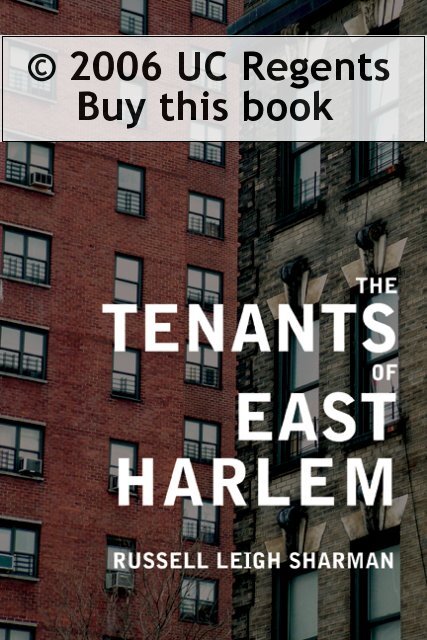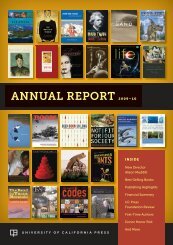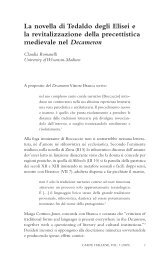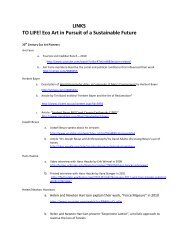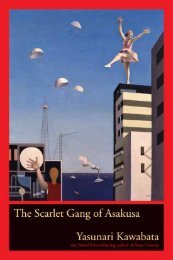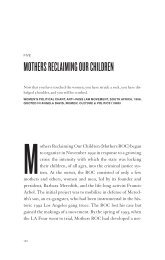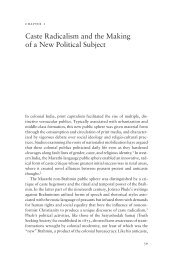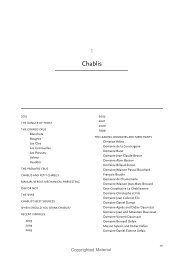Read Chapter 1 (PDF) - University of California Press
Read Chapter 1 (PDF) - University of California Press
Read Chapter 1 (PDF) - University of California Press
Create successful ePaper yourself
Turn your PDF publications into a flip-book with our unique Google optimized e-Paper software.
© 2006 UC Regents<br />
Buy this book
<strong>University</strong> <strong>of</strong> <strong>California</strong> <strong>Press</strong>, one <strong>of</strong> the most distinguished university<br />
presses in the United States, enriches lives around the world by advancing<br />
scholarship in the humanities, social sciences, and natural sciences. Its<br />
activities are supported by the UC <strong>Press</strong> Foundation and by philanthropic<br />
contributions from individuals and institutions. For more information, visit<br />
www.ucpress.edu.<br />
<strong>University</strong> <strong>of</strong> <strong>California</strong> <strong>Press</strong><br />
Berkeley and Los Angeles, <strong>California</strong><br />
<strong>University</strong> <strong>of</strong> <strong>California</strong> <strong>Press</strong>, Ltd.<br />
London, England<br />
© 2006 by The Regents <strong>of</strong> the <strong>University</strong> <strong>of</strong> <strong>California</strong><br />
Library <strong>of</strong> Congress Cataloging-in-Publication Data<br />
Sharman, Russell Leigh, 1972–.<br />
The tenants <strong>of</strong> East Harlem / Russell Leigh Sharman.<br />
p. cm.<br />
Includes bibliographical references and index.<br />
isbn-13: 978-0-520-24427-6 (cloth : alk. paper), isbn-10: 0–520–24427–3<br />
(cloth : alk. paper)<br />
isbn-13: 978-0-520-24747-5 (pbk. : alk. paper), isbn-10: 0–520–24747–7<br />
(pbk. : alk. paper)<br />
1. Sociology, Urban—New York (State)—New York. 2. Urban<br />
anthropology—New York (State)—New York. 3. Ethnicity—New York<br />
(State)—New York. 4. Community development, Urban—New York<br />
(State)—New York. 5. Gentrification—New York (State)—New York.<br />
6. East Harlem (New York, N.Y.)—Social conditions. 7. East Harlem<br />
(New York, N.Y.)— Economic conditions. 8. East Harlem (New York,<br />
N.Y.)— Social life and customs. I. Title.<br />
HN80.N5S53 2006<br />
305.8’009747’1—dc22 2005021225<br />
Manufactured in the United States <strong>of</strong> America<br />
15 14 13 12 11 10 09 08 07 06<br />
10 9 8 7 6 5 4 3 2 1<br />
This book is printed on New Leaf EcoBook 60, containing 60% postconsumer<br />
waste, processed chlorine free; 30% de-inked recycled fiber, elemental<br />
chlorine free; and 10% FSC-certified virgin fiber, totally chlorine<br />
free. EcoBook 60 is acid free and meets the minimum requirements <strong>of</strong><br />
ansi/astm d5634–01 (Permanence <strong>of</strong> Paper).
ONE<br />
East Harlem<br />
East Harlem sustains two ongoing and <strong>of</strong>ten competing narratives <strong>of</strong><br />
urbanism: one inscribed in concrete and the other in flesh. People conform<br />
to the built environment just as the built environment conforms to people<br />
over the course <strong>of</strong> generations and centuries. The story <strong>of</strong> East Harlem is<br />
written in the sidewalks and storefronts, the abandoned buildings and<br />
corner bodegas, the public school yards and project courtyards as much<br />
as it is written in the lives <strong>of</strong> Puerto Ricans and African Americans, Italians<br />
and Mexicans, new immigrants and old. To understand East Harlem, one<br />
must understand how these two narratives fit together, how people transform<br />
the streets and how the streets transform the people.<br />
Between 96th and 125th Streets, Fifth Avenue and the East River, East<br />
Harlem lies just beyond the printed boundaries <strong>of</strong> most tourist maps and<br />
the imaginations <strong>of</strong> most Manhattan residents. There, in little more than<br />
1
2<br />
east harlem<br />
two hundred city blocks, live more than one hundred thousand people.<br />
Italian, Puerto Rican, African American, Mexican, West African, Chinese,<br />
and more than two dozen other national and ethnic groups constitute<br />
one <strong>of</strong> the most diverse communities in New York City.<br />
What follows is a biography <strong>of</strong> the neighborhood, a dual narrative <strong>of</strong><br />
place and people that extends through time but is limited to a very specific<br />
space. The people introduced in each chapter model the ethnic distinctions<br />
that divide the neighborhood. There is the old guard: Pete, 1 one<br />
<strong>of</strong> the last Italian holdouts on the same block as Rao’s famous Italian<br />
restaurant; José, a second-generation Puerto Rican resident who fled the<br />
crime <strong>of</strong> the 1980s, only to return more committed than ever to El Barrio;<br />
and Lucille, 2 an African American living in the shadow <strong>of</strong> the other<br />
Harlem and standing up to the daily demoralizations <strong>of</strong> public housing.<br />
There are more recent immigrants who seem likely to change the face <strong>of</strong><br />
the community as drastically as earlier arrivals: Maria, 3 an undocumented<br />
Mexican who has run the gauntlet <strong>of</strong> La Frontera, twice, to be a<br />
hairstylist in East Harlem; Mohamed, who came to New York from<br />
Guinea to open his own store just down the avenue from the mosque on<br />
96th Street; and Si Zhi, a civil engineer from China whose night-shift job<br />
in the lobby <strong>of</strong> a Times Square hotel paid for his own building in the<br />
neighborhood. Finally, there are the newest immigrants to East Harlem,<br />
upwardly mobile whites fleeing downtown rent increases and settling in<br />
the newly renovated buildings that anticipated an expanding market.<br />
The new migration is most visible in the refurbished buildings, new commercial<br />
franchises, and new upscale restaurants featuring live jazz. But<br />
urban renewal comes at a price as Pete, José, Lucille, Maria, Mohamed,<br />
and Si Zhi face the looming uncertainty <strong>of</strong> market fluctuations and their<br />
ability to hang on in a moment <strong>of</strong> cataclysmic change.<br />
East Harlem is a community defined by the attachments <strong>of</strong> its inhabitants.<br />
The life stories that I present explore how roots sink so deep so<br />
quickly in a community that has always hosted the city’s most recent<br />
arrivals, how new immigrants challenge the claims <strong>of</strong> the old, and how<br />
that cycle is now threatened as never before by the specter <strong>of</strong> gentrification.<br />
But first, let us take a tour <strong>of</strong> the neighborhood.
east harlem 3<br />
block by block . . .<br />
An oversized concrete mosque dominates the corner <strong>of</strong> 96th Street and<br />
Third Avenue. Still unfinished but obviously thriving, the mosque is one<br />
<strong>of</strong> several institutions that mark the physical boundaries <strong>of</strong> the neighborhood.<br />
A few blocks away, between Second and First Avenues, stands<br />
Metropolitan Hospital, a large public institution that serves the majority<br />
<strong>of</strong> residents who have little or no health care coverage. On the opposite<br />
border, nestled in the most affluent corner <strong>of</strong> East Harlem on Fifth<br />
Avenue, lies Mt. Sinai Hospital. Mt. Sinai is an even larger voluntary hospital,<br />
serving the well-to-do <strong>of</strong> the Upper East Side and the few well<br />
insured <strong>of</strong> East Harlem. These buildings at the southern border <strong>of</strong> East<br />
Harlem mark <strong>of</strong>f the barrio and stand out from the largely undifferentiated<br />
low-slung buildings <strong>of</strong> the neighborhood.<br />
Standing next to the mosque, at the top <strong>of</strong> the hill on 96th Street that<br />
descends down into East Harlem, you can tell it’s Friday by the black Lincoln<br />
Town Cars triple-parked along Third Avenue. The cars, lined up like<br />
a UN motorcade or a dignitary’s funeral procession, wait for their owners<br />
to finish their afternoon prayers. They are the “gypsy cabs” that serve<br />
East Harlem and neighborhoods like it. The ubiquitous yellow taxis <strong>of</strong><br />
Manhattan rarely cross the border at 96th Street without a paying customer<br />
already inside, usually headed for La Guardia Airport via the Triboro<br />
Bridge at 125th Street and First Avenue. Instead, the streets <strong>of</strong> East<br />
Harlem teem with the dark sedans <strong>of</strong> gypsy cab drivers, tapping their<br />
horns at each intersection to interest potential customers. The gypsy cabs<br />
are driven mostly by entrepreneurial West Africans who have managed<br />
to save enough cash to buy a car and work as illicit “wholesale” vendors<br />
on the streets. They <strong>of</strong>fer reliable car service to local residents based on<br />
negotiated rates. With no meters and little regulation, the gypsy cabs are<br />
as illegal as street vendors, but the city has long abdicated control over<br />
this niche <strong>of</strong> the informal economy.<br />
North along Third Avenue, past the mosque and Metropolitan Hospital,<br />
the street level is dominated by the thriving commerce <strong>of</strong> 99-cent<br />
stores, corner bodegas, discount clothing stores, and fast-food restau-
4<br />
east harlem<br />
rants. Sidewalks, split by weather and speckled with spit and chewing<br />
gum, are crowded with merchandise spilling from the open doors <strong>of</strong> discount<br />
stores and the folding tables <strong>of</strong> temporary merchants. Sweat suits<br />
and evening gowns, underwear and overcoats hang on racks and lie in<br />
bins, selling two for one and guarded by employees lounging in chairs<br />
held together with duct tape and speaker wire. Music tumbles from windows<br />
above and cars below—salsa, soul, rap, and reggae—blending with<br />
the Spanish, English, Mandarin, and Wol<strong>of</strong> spoken and catcalled from<br />
the vendors and customers. The smells <strong>of</strong> snow cones and bacalaito,<br />
uncollected garbage and fresh-cut flowers combine. Jewelry stores, pawn<br />
shops, hardware stores, dry cleaners, liquor stores, and pharmacies mark<br />
the distance from one block to the next. There is now a McDonald’s every<br />
seven blocks from 96th to 125th Street.<br />
And there, at almost every corner, <strong>of</strong>ten obscured by dumpsters and<br />
scaffolding, are the public galleries <strong>of</strong> urban art. Some bear the scars <strong>of</strong><br />
turf wars, the “tagging” <strong>of</strong> graffiti writers, but most display a more discrete<br />
mural art aesthetic. Many mark buildings with the portraits <strong>of</strong><br />
entertainers, an homage to the rap artist Biggie Smalls or the salsa king<br />
Tito Puente. Others carry explicitly political themes, declaring Puerto<br />
Rican independence or protesting the bombing <strong>of</strong> Vieques. One artist<br />
dominates this genre, a young Puerto Rican named James de la Vega who<br />
has left his mark in religious, pop cultural, and art historical iconography<br />
throughout the neighborhood. But the most common form <strong>of</strong> public<br />
mural art is <strong>of</strong>ten the most transient, the RIPs, or Rest in Peace murals,<br />
that mark the sites <strong>of</strong> violence. The colorful collages <strong>of</strong> the deceased’s<br />
likeness along with the symbols <strong>of</strong> the person’s passions or an ode composed<br />
by a loved one serve as semipermanent reminders <strong>of</strong> loss. Most <strong>of</strong><br />
these are charred by the soot <strong>of</strong> temporary altars fashioned from cardboard<br />
boxes, votive candles, and liquor bottles.<br />
Above, the skyline is a low-lying, seven-story maximum, occasionally<br />
disrupted by the towering public housing projects at 98th, 106th, 110th,<br />
112th, and 125th Streets. The lower buildings display an arresting array<br />
<strong>of</strong> color above the bacchanal <strong>of</strong> commerce at street level. Old tenements<br />
<strong>of</strong> green, blue, red, and white form orderly canyons, guiding the streets<br />
and avenues as they neatly dissect the neighborhood. Rising high above
east harlem 5<br />
are the housing projects. The drab, muddy brick monoliths seem naked<br />
and unfinished, like foundation posts for some impossibly larger building.<br />
And the taller, more obtrusive buildings not only disrupt the riot <strong>of</strong><br />
color; they also disrupt the orderly grid the older, smaller buildings work<br />
so hard to maintain. Organized around so-called superblocks, the housing<br />
projects razed micro-communities and closed <strong>of</strong>f streets to create<br />
building complexes centered on green spaces. Heralded as a miracle <strong>of</strong><br />
modern urban planning and a model for democratic housing, the projects<br />
were given names like Jefferson, Washington, and Johnson. But with<br />
no stores and no restaurants, the superblocks killed <strong>of</strong>f the street life and<br />
quickly turned their green spaces into some <strong>of</strong> the most fearsome real<br />
estate in the city. 4<br />
The steady march north past short blocks and narrow streets is<br />
arrested at 106th Street, the first <strong>of</strong> two wide, two-way streets that intersect<br />
the neighborhood. On the corner <strong>of</strong> 106th Street and Third Avenue<br />
there are the telltale signs <strong>of</strong> relatively recent economic investment: KFC,<br />
Blockbuster, and a shiny new chain pharmacy. But there are also the<br />
indelible marks <strong>of</strong> the Puerto Rican community, the midcentury immigration<br />
trend that turned East Harlem into Spanish Harlem and El Barrio.<br />
La Fonda Boriqua sits just behind Blockbuster Video, serving up<br />
Puerto Rican comfort food to the local literati. And just down the street,<br />
at Lexington Avenue, is the heart <strong>of</strong> Puerto Rican East Harlem.<br />
The 197-A Plan to revitalize East Harlem developed by the community<br />
board, calls the intersection <strong>of</strong> 106th Street and Lexington Avenue the<br />
“Cultural Crossroads.” On one corner stands the Julia de Burgos Cultural<br />
Center, a somewhat controversial private enterprise that houses an<br />
upscale art gallery, music studio, and performance space. On Thursday<br />
nights the renovated public school building plays host to “Julia’s Jam,”<br />
an open mike event for Bomba y Plena music and Nuyorican poetry. Just<br />
next door is the spiritual anchor for the Latino Catholic community, St.<br />
Cecilia’s Church. The large, ruddy red brick building dominates the<br />
block and still <strong>of</strong>fers most <strong>of</strong> its services in Spanish. St. Cecilia’s also<br />
houses Opus 118, the violin program made famous by Meryl Streep’s<br />
film Music <strong>of</strong> the Heart. Across the street is Metropolitan Studios, new<br />
home to Black Entertainment Television. Facing St. Cecilia’s Church and
6<br />
east harlem<br />
the Julia de Burgos Cultural Center, Metropolitan Studios is a physical<br />
reminder <strong>of</strong> the African American presence in the community, most<br />
notably in its highly rated video music program, “106th and Park.”<br />
West <strong>of</strong> the Cultural Crossroads, at 106th Street and Park Avenue, a<br />
third <strong>of</strong> East Harlem is sliced <strong>of</strong>f by the elevated Metro North railway.<br />
Bursting from underneath the streets <strong>of</strong> the Upper East Side at 98th Street,<br />
the chunky granite and steel viaduct carries <strong>of</strong>fice-weary workers north to<br />
Westchester and beyond. Gliding across the cityscape at the ro<strong>of</strong>line, commuters<br />
are carried swiftly over and through the neighborhood that was<br />
founded in part to house the workers that built the tracks. Down below,<br />
the arches carved through stone at each intersection gape like forbidden<br />
caves, daring pedestrians to enter their unlit murky passageways. Stalactites<br />
<strong>of</strong> unidentifiable ooze hang overhead, and the stench <strong>of</strong> human waste<br />
hurries most against the light and into oncoming traffic.<br />
Back into daylight and on toward the western border, the institutional<br />
buildings <strong>of</strong> public housing, public schools, and the hinterlands <strong>of</strong> Mt.<br />
Sinai Hospital mark the way toward the northern edge <strong>of</strong> Central Park<br />
and the famed Museum Mile. On the right, a public school yard is an<br />
assault <strong>of</strong> color. The graffiti “wall <strong>of</strong> fame” was designed to channel the<br />
creative energy <strong>of</strong> so-called urban vandals. A rotating mishmash <strong>of</strong> style<br />
and theme, the ball court–turned–outdoor gallery stands as an open-air,<br />
contested counterpoint to the institutionalization <strong>of</strong> art and “culture”<br />
awaiting at Fifth Avenue.<br />
Fifth Avenue, known as Museum Mile because <strong>of</strong> its elite institutions,<br />
includes the Guggenheim and the Met. But two museums mark the<br />
western boundary <strong>of</strong> East Harlem at Fifth Avenue: the Museum <strong>of</strong> the City<br />
<strong>of</strong> New York at 104th Street and El Museo del Barrio at 105th Street. Like<br />
the mosque and the hospitals that guard the southern border, these two<br />
institutions <strong>of</strong> history and art face the western approach. Both occupy<br />
grand buildings on the avenue, and both face the Conservatory Garden,<br />
one <strong>of</strong> the most secluded and peaceful gated gardens <strong>of</strong> Central Park. But<br />
each has its own relationship to the neighborhood: one a museum <strong>of</strong> New<br />
York that blurs the line between city and community; the other a museum<br />
<strong>of</strong> the community that redraws the lines <strong>of</strong> division through art and<br />
performance.
east harlem 7<br />
A few blocks north <strong>of</strong> the two museums, a small brick plaza redirects<br />
traffic around the corner <strong>of</strong> Fifth Avenue and 110th Street. Lifted high<br />
above the street on a platform supported by figures <strong>of</strong> nude women,<br />
Duke Ellington stands regally next to a baby grand piano. The monument<br />
anchors the southwest corner <strong>of</strong> Central Harlem, the capital <strong>of</strong><br />
Black America, where Duke Ellington reigned as most influential musician.<br />
But Duke does not face Harlem. He gazes across the other half <strong>of</strong><br />
that traffic circle, which remains starkly empty <strong>of</strong> any similar memorial,<br />
into East Harlem. When Tito Puente died just three years after the installation<br />
<strong>of</strong> the Duke Ellington statue, Puerto Ricans were quick to rename<br />
110th Street Tito Puente Way, and plans were set in motion to erect a<br />
statue, facing Duke, <strong>of</strong> Tito and his timbales.<br />
A few blocks east, past the trestle <strong>of</strong> the Metro North railway at Park<br />
Avenue, is the intersection <strong>of</strong> 110th Street and Lexington Avenue, perhaps<br />
the most infamous corner in East Harlem. In the 1980s this was the<br />
epicenter <strong>of</strong> the crack cocaine catastrophe that rocked New York City.<br />
Made infamous by Philippe Bourgois’s book In Search <strong>of</strong> Respect, the corner<br />
has long been known by locals as a haunt for drug dealers and violence.<br />
Even the post <strong>of</strong>fice located at the intersection seems to echo this<br />
mystique with the ominous “Hell Gate Station” emblazoned above its<br />
entrance.<br />
Since the beginning <strong>of</strong> the 1990s, the intersection <strong>of</strong> 110th and Lexington<br />
has made a slow climb out <strong>of</strong> disrepute. Thanks in part to an improved<br />
economy and more effective policing, the area has witnessed a few more<br />
<strong>of</strong> its abandoned buildings–cum–crack houses transformed into restaurants,<br />
grocery stores, and bodegas. Even the public library on 110th got a<br />
much-needed face-lift. Though drugs now change hands out <strong>of</strong> sight for<br />
the most part, the corner remains a constant reminder that East Harlem is<br />
a few subway stops and a world away from the rest <strong>of</strong> Manhattan.<br />
Up the narrow canyon <strong>of</strong> Lexington Avenue, the thick odor <strong>of</strong> deepfried<br />
food fills the air. Local cuchifritos entice pedestrians with greasy clear<br />
plastic facades filled with stacks <strong>of</strong> deep-fried fare distinguished only<br />
by size and shape. Chinese restaurants, most no wider than the door itself,<br />
serve up lo mein, chicken wings, and fried plantains to go, trying<br />
to keep up with the tastes <strong>of</strong> the neighborhood. And there is the ever-
8<br />
east harlem<br />
popular fast-food knock<strong>of</strong>f, like Kennedy Fried Chicken with its oddly<br />
familiar red-and-white logo, that <strong>of</strong>fers the eponymous poultry along<br />
with pizza, burgers, and the occasional egg roll, all prepared behind the<br />
safety <strong>of</strong> Plexiglas. Plexiglas does a thriving business in East Harlem.<br />
Nowhere is this more apparent than in the liquor stores that are as<br />
common in the neighborhood as intersections. Open later than most<br />
businesses, liquor stores are easy to spot at night, casting their fluorescent<br />
glow onto the sidewalk and street, collecting three or four loiterers<br />
like moths to a flame. Inside, the retail stores have the feel <strong>of</strong> a wholesale<br />
distributor, their wares displayed in bulk behind a wall <strong>of</strong> Plexiglas. Customers<br />
mill about in one or two lines, waiting for their turns at the plastic<br />
lazy Susan that spins away their money and spins back a bottle <strong>of</strong><br />
Hennessey, Pisco, or wine.<br />
Farther up the street you will likely find another mainstay in the local<br />
small business economy, the botanica. One-stop shopping for syncretic<br />
Catholicism, botanicas cater to the Old Country beliefs <strong>of</strong> older Puerto<br />
Rican immigrants. Window displays are public folk art museums, with<br />
effigies, icons, amulets, and artifacts. Inside, a busy Caribbean market<br />
brought indoors, bins full <strong>of</strong> herbs, pots for potions, and all manner <strong>of</strong><br />
incendiary magic crowd the narrow aisles. Votive candles, slender glass<br />
holders filled with colored wax and painted with images <strong>of</strong> worship, are<br />
on <strong>of</strong>fer for every occasion—one for a prayer to the Virgin Mary, another<br />
for St. Jude, and even one with a space for filling in a lottery number with<br />
a magic marker.<br />
But the true mainstay <strong>of</strong> the East Harlem economy, the barrio equivalent<br />
<strong>of</strong> the general store, is the corner bodega. Entry-level operations in<br />
the formal economy, bodegas in East Harlem, as elsewhere in New York,<br />
are the last vestige <strong>of</strong> the mom-and-pop store in the homogenized city.<br />
They are the touchstones <strong>of</strong> micro-neighborhood identification.There is<br />
hardly a block without at least one bodega, hardly a bodega that doesn’t<br />
serve one discrete, circumscribed urban space. They are the proscenium<br />
<strong>of</strong> storefront socialization. But for all their support <strong>of</strong> the individualized<br />
entrepreneurial spirit, bodegas thrive on their uniformity as much as<br />
Starbucks, Blockbuster, or KFC. They have the same colorful facades,<br />
announcing the same assortment <strong>of</strong> wares under the same emblem, the
east harlem 9<br />
“Deli Grocery” (don’t look for the word bodega on the signage), the same<br />
racks <strong>of</strong> 50-cent snack food, the same cases <strong>of</strong> soda, the same deli counters,<br />
the same aisles <strong>of</strong> cleansers and toilet paper. And the same rules <strong>of</strong><br />
exchange apply at each Plexiglas cashier’s window: the wordless pantomime<br />
between customer and owner; prices dictated by the whim <strong>of</strong> the<br />
teller; and no need to form a line; if you know the price, just make sure<br />
the cashier can see your money laid out on the counter.<br />
As you move from 110th Street up Lexington Avenue, you pass<br />
through the three-block-wide swath <strong>of</strong> public housing that was carved<br />
out <strong>of</strong> East Harlem from First Avenue to Lenox Avenue in Central<br />
Harlem to 116th Street, which marks the second <strong>of</strong> the two main eastwest<br />
thoroughfares in the neighborhood. To the west, the elevated Metro<br />
North continues its trek along Park Avenue sheltering the defunct La<br />
Marqueta, a once-thriving Puerto Rican produce market. To the east, a<br />
noticeable shift in the street aesthetic begins to take hold. The red, white,<br />
and blue flags <strong>of</strong> Puerto Rican stalwarts give way to the green and red<br />
banners <strong>of</strong> Mexican newcomers.<br />
If 106th Street marks the cultural crossroads <strong>of</strong> Puerto Rican East<br />
Harlem, 116th Street is the new nexus <strong>of</strong> Mexican East Harlem. Specialty<br />
groceries bathed in green and red <strong>of</strong>fer imports from provincial outposts<br />
in the home country. Restaurants like La Hacienda let the ballads <strong>of</strong><br />
northern Mexico fill the street, drowning out the salsa music from apartments<br />
upstairs. Travel agencies advertise one-way rates to Mexico City,<br />
Oaxaca, and Guadalajara. And just one block north stands another mark<br />
<strong>of</strong> Mexican East Harlem, a massive mural in the great tradition <strong>of</strong> Mexican<br />
muralists dedicated to the Zapatista movement in southern Mexico.<br />
Farther east, 116th Street is brought up short against the concrete<br />
retaining walls <strong>of</strong> the FDR Parkway and the East River beyond—but not<br />
before crossing Pleasant Avenue, the last truncated stretch <strong>of</strong> concrete<br />
before the eastern border. From Jefferson Park at 114th Street to the Wagner<br />
housing project on 120th, Pleasant Avenue is still considered the Italian<br />
section <strong>of</strong> East Harlem. Here, in the quietest corner <strong>of</strong> East Harlem,<br />
the numbered streets dead-end into the parkway or the ruins <strong>of</strong> the abandoned<br />
wire factory that spreads over several blocks awaiting a new<br />
Home Depot and Costco wholesale club.
10<br />
east harlem<br />
The stores at this eastern edge <strong>of</strong> East Harlem are a mix <strong>of</strong> commerce,<br />
but many still bear the marks <strong>of</strong> Italian Harlem: Ray’s Italian Ice, Morrone’s<br />
Bakery, or the original Patsy’s, which still lures downtown pizza<br />
fetishists to its brick oven. Rao’s remains the most famous landmark <strong>of</strong> a<br />
fading glory. Its thick red facade welcomes many <strong>of</strong> New York’s elite,<br />
their limousines waiting to whisk them back safely to civilization after<br />
the second seating. Legend surrounds the place, rumors <strong>of</strong> a six-month<br />
waiting list and connections to the Genovese crime family, but most<br />
locals have never seen the inside. The stories themselves are probably<br />
more satisfying.<br />
Despite the lasting fame <strong>of</strong> its eateries, the most defining features <strong>of</strong><br />
Pleasant Avenue and its paved tributaries are its churches. A few neo-<br />
Gothic temples <strong>of</strong> Catholicism that once served an overcrowded Italian<br />
enclave now minister to the new wave <strong>of</strong> Latino faithful. Our Lady <strong>of</strong> Mt.<br />
Carmel remains the patroness <strong>of</strong> Pleasant Avenue, drawing back thousands<br />
<strong>of</strong> Italian Harlem expatriates for her annual feast day in July. Next<br />
door to her shrine on 115th Street, the new red brick National Museum<br />
<strong>of</strong> Catholic Art and History is set to replace the storefront version in the<br />
near future. But even the enshrined Catholicism has had to give way to<br />
Pentecostalism springing up in the shadows. The tumult <strong>of</strong> tambourines,<br />
guitars, and glossalalia crowds the solemn soundscape on Sundays and<br />
dominates during irregular prayer meetings throughout the week.<br />
At 120th Street, Pleasant Avenue runs into Wagner Houses, a public<br />
housing project nestled in the shadows <strong>of</strong> the Triboro Bridge. Just the<br />
other side <strong>of</strong> its abandoned green space and seldom-used common areas<br />
lies 125th Street, the northern border <strong>of</strong> East Harlem. This is the last <strong>of</strong> the<br />
busy thoroughfares that divide the community into ten-block increments,<br />
and like its counterpart at 96th Street, it marks a palpable boundary<br />
between one world and the next.<br />
West <strong>of</strong> Fifth Avenue, 125th Street, also known as Martin Luther King<br />
Jr. Boulevard, is Central Harlem’s economic artery and cultural center.<br />
It is also the center <strong>of</strong> Central Harlem’s economic development and urban<br />
renewal. Magic Johnson’s movie theater and the Starbucks c<strong>of</strong>fee<br />
shop formed a bulwark for future investment, and soon chain stores<br />
anchored the intersections <strong>of</strong> Malcolm X, Adam Clayton Powell, and
east harlem 11<br />
Frederick Douglass Avenues. It was and is a socioeconomic revolution<br />
that spread to Central Harlem’s housing market and produced what some<br />
have called a second Harlem Renaissance. Unfortunately, for many, it has<br />
meant an erosion <strong>of</strong> African American influence over an eerily familiar<br />
frenzy <strong>of</strong> real estate speculation.<br />
On the other side <strong>of</strong> Fifth Avenue, the East Harlem side <strong>of</strong> 125th Street,<br />
this trend is visible in the changing face <strong>of</strong> the built environment. The<br />
Metro North station at 125th Street, where the railway makes its last stop<br />
in Manhattan before heading out <strong>of</strong> the city, is a renovated art deco homage<br />
to the economic changes. One block east, a behemoth Pathmark<br />
supermarket caters to every need, leaving the bodegas and 99-cent stores<br />
to wither and fade, and a shiny new <strong>of</strong>fice complex waits in joyful hope<br />
that commuters will find the 125th Street station as convenient as Grand<br />
Central.<br />
From 96th Street to 125th, Fifth Avenue to the East River, East Harlem<br />
block by block, bodega to liquor store, tenement to project. From the<br />
transformation at 96th to the transformation at 125th, the neighborhood<br />
is a study in contrasts, an assault on the senses that is unrelenting and<br />
always changing.<br />
. . . and person by person<br />
East Harlem cast in concrete is only half the story. Running alongside and<br />
<strong>of</strong>ten counter to it is the other half, the flesh and bone that has inhabited<br />
this rectangle <strong>of</strong> urban space day after day for the past few centuries.<br />
Inasmuch as this book is the story <strong>of</strong> those streets, it is also the story <strong>of</strong><br />
these people. Moving in and out, over and under the sulking buildings<br />
and sagging sidewalks, the tenants <strong>of</strong> East Harlem have carved a life<br />
from this place, a life for themselves and for their neighbors.<br />
Dividing up the streets into micro-communities, residents have long<br />
dug in and held fast to their corner <strong>of</strong> the neighborhood, filling each<br />
niche with the social clubs and restaurants, murals and flags that defend<br />
the claims <strong>of</strong> Italians against Puerto Ricans, <strong>of</strong> Puerto Ricans against<br />
Mexicans, <strong>of</strong> old-timers against newcomers. The streets, <strong>of</strong> course, know
12<br />
east harlem<br />
the bitter irony. The turf so zealously guarded by some today will be just<br />
as important to others tomorrow. It’s a running joke among the silent participants,<br />
the buildings themselves: the concrete endures, but the people<br />
rarely last.<br />
In these pages you will meet Pete, José, Lucille, Maria, Mohamed, Si<br />
Zhi, and me. We are the players: one life story for each <strong>of</strong> the streets and<br />
avenues that play host to a self-selected collective; one life story for each<br />
<strong>of</strong> the self-defined ethnic and national groups that dominate East<br />
Harlem.<br />
In “Pleasant Avenue: The Italians,” you will meet Pete, a third-generation<br />
Italian who was born on 114th Street near Pleasant Avenue in the<br />
1920s. He’s a small man with a shock <strong>of</strong> silver hair and the toothless grin<br />
<strong>of</strong> unassuming wisdom. His memories tumble out in vignettes <strong>of</strong> his<br />
mother sewing leather gloves in the basement, <strong>of</strong> his gang, the Seahawks,<br />
and their social club, <strong>of</strong> his building razed to make way for public housing<br />
projects, <strong>of</strong> his neighborhood changing before his eyes. Now Pete<br />
presides over 114th Street, just a block from his long-forgotten tenement<br />
birthplace, in his plaid-striped, folding lawn chair. Balanced precariously<br />
over the broken sidewalk in front <strong>of</strong> his building, Pete reads his Daily<br />
News and regales the non-Italian youth with stories <strong>of</strong> his East Harlem,<br />
Italian Harlem. “This used to be all Italian, only Italian,” he will say from<br />
his chair, watching the children play in Jefferson Park across the street,<br />
“not like today.”<br />
Italians were the first dominant ethnic group <strong>of</strong> the twentieth century<br />
in East Harlem. As Pete likes to brag, “There were more Italians on 112th<br />
Street between First and Third than anywhere else in the country.” German<br />
and Irish Catholics, who had settled earlier, were ruthless in their<br />
discrimination against the southern Italian immigrants, 5 but by the 1920s<br />
their numbers overwhelmed every other ethnic claim to the neighborhood.<br />
Many <strong>of</strong> the German and Irish Catholics, as well as European Jews,<br />
began to flee East Harlem. 6 This Italian territorial victory would not last<br />
long, however, as African Americans moved into the vacancies left by<br />
Europeans fleeing the Italian “invasion,” and, just a decade later, the<br />
unprecedented influx <strong>of</strong> Puerto Ricans overwhelmed even the Italian<br />
claim to the neighborhood.
east harlem 13<br />
Today most <strong>of</strong> Pete’s Italian neighbors and all <strong>of</strong> his family have long<br />
since died or moved away. Indeed, Pete’s story demonstrates, perhaps<br />
more clearly than elsewhere, the complete cycle <strong>of</strong> intracity migration,<br />
from early influx to permanent settlement to upward mobility and abandonment.<br />
Part <strong>of</strong> this story is the story <strong>of</strong> public housing in New York—<br />
how visionary urban planners turned a thriving community into a<br />
demographic dumping ground in less than a decade. Pete is a witness to<br />
that transformation, but he is also a witness to the early history <strong>of</strong> Italian<br />
settlement along this avenue and its tributary streets, from the youth<br />
gang rumbles to the aging social clubs, establishing the well-worn pattern<br />
<strong>of</strong> ethnic immigration that echoes in each <strong>of</strong> the stories that follow.<br />
In “106th Street: The Puerto Ricans,” you will meet José. A scrappy<br />
Puerto Rican kid, José grew up, dodged gangs, and met his wife on the<br />
streets <strong>of</strong> East Harlem. After a tour in the army as far away as Staten<br />
Island and a brief sojourn in Florida during the crack cocaine epidemic <strong>of</strong><br />
the 1980s, José returned to the neighborhood with his wife, Cecilia, to<br />
raise their children. Wearing a Day-Glo Jets jacket and carrying a digital<br />
camera, he is a permanent fixture on the streets around 106th Street now.<br />
José maintains a website for the community, www.east-harlem.com, an<br />
evolving ode to a patch <strong>of</strong> New York real estate that, for all intents and<br />
purposes, was annexed by Puerto Rico after Puerto Rico was annexed by<br />
the United States.<br />
José was born in the 1950s, the decade <strong>of</strong> legend in Puerto Rican East<br />
Harlem. In the era after World War II, hundred <strong>of</strong> thousands <strong>of</strong> Puerto<br />
Ricans were encouraged to leave the island for the United States, New<br />
York City in particular. In the first year after the war, 39,000 Puerto Ricans<br />
made the journey, with an annual average <strong>of</strong> 50,000 in the next decade.<br />
Another 586,000 Puerto Ricans would leave the island for New York City<br />
in the 1960s. 7 It was a mass migration that rivaled that <strong>of</strong> the Italians<br />
before World War I, with two crucial differences. Since 1898 the United<br />
States has maintained an ambiguous claim on the island, and since 1952<br />
Puerto Rico has remained in political limbo, neither wholly independent<br />
as a nation nor fully incorporated as a state. 8 The Puerto Ricans arriving<br />
in New York in the twentieth century were not immigrants like the Italians;<br />
they were southern migrants, no different in legal terms from
14<br />
east harlem<br />
African Americans moving north after the Civil War. In addition, unlike<br />
turn-<strong>of</strong>-the-century immigrants who took advantage <strong>of</strong> a booming industrial<br />
economy, Puerto Rican settlers entered the labor market at a time<br />
when North America, especially New York City, was shifting from an<br />
industrial to a service-based economy. 9 This left many thousands <strong>of</strong><br />
Puerto Rican newcomers at a distinct disadvantage.<br />
José’s story explores the institutionalization <strong>of</strong> Puerto Rican identity<br />
along the broad stretches <strong>of</strong> 106th Street, chronicling the transformation<br />
<strong>of</strong> East Harlem from an Italian to a Puerto Rican community and the way<br />
in which Puerto Rican newcomers managed to become the old guard in<br />
a few short decades. Unlike Italians, Puerto Ricans were citizen immigrants,<br />
a peculiar paradox that would haunt them into the twenty-first<br />
century. José’s story focuses on the process <strong>of</strong> Puerto Rican entrenchment,<br />
playing on the ambiguous nationalism that stirs most <strong>of</strong> the local<br />
residents to shore up the boundaries <strong>of</strong> their community in the face <strong>of</strong> yet<br />
another wave <strong>of</strong> immigration. José is the face <strong>of</strong> these changes, born on<br />
the streets <strong>of</strong> East Harlem and fighting to hold on to El Barrio.<br />
“125th Street: The African Americans” is Lucille’s story. Sitting in the<br />
lobby <strong>of</strong> UPACA Gardens, Lucille presides with embittered optimism<br />
over the slow decline <strong>of</strong> public housing in the neighborhood. Born on<br />
117th Street in East Harlem, she played double Dutch in the shadow <strong>of</strong> the<br />
elevated train, innocent <strong>of</strong> the struggle undertaken by her mother and<br />
grandparents in their move from the South. But when her mother died<br />
quietly in a Harlem social club, she was swept into a subsidized existence<br />
<strong>of</strong> welfare and public housing. A young woman with a daughter <strong>of</strong> her<br />
own and two brothers to care for, Lucille refused to take help for granted.<br />
She created a youth center in the basement <strong>of</strong> her building and more than<br />
thirty years later still sits tenant patrol in the evenings. The tenements <strong>of</strong><br />
her childhood are all gone now, replaced with upscale townhouses and<br />
priced out <strong>of</strong> reach, but she can still see what once was—street life as community,<br />
the extended family <strong>of</strong> neighbors and friends.<br />
African Americans settled east <strong>of</strong> Fifth Avenue long before the first<br />
housing projects were built in the 1940s and before Puerto Rican migration<br />
began in earnest. The post-Reconstruction mass migration <strong>of</strong> African<br />
Americans out <strong>of</strong> the southern United States and into the industrialized
east harlem 15<br />
North radically transformed the demographics <strong>of</strong> cities like New York,<br />
and upper Manhattan became an enclave community from the first years<br />
<strong>of</strong> the twentieth century. The reputation <strong>of</strong> Central Harlem as the capital<br />
<strong>of</strong> Black America is now well ensconced, and at the turn <strong>of</strong> the century<br />
Fifth Avenue was not the discrete boundary it is today. East Harlem,<br />
though at the time already considered a European ghetto with thousands<br />
<strong>of</strong> Irish, German, and Italian settlers, was close enough to the excitement<br />
<strong>of</strong> the Harlem Renaissance for thousands <strong>of</strong> African Americans to put<br />
down roots. Indeed, Central Harlem remained the center <strong>of</strong> African<br />
American attention, even as Italians and then Puerto Ricans established<br />
the Fifth Avenue boundary throughout the twentieth century.<br />
Lucille represents the African Americans who have long debated the<br />
Puerto Ricans as to the ethnic character <strong>of</strong> East Harlem and its relationship<br />
to Central Harlem. Since 1990, with urban renewal driving more and<br />
more African Americans out <strong>of</strong> Central Harlem, non-Hispanic black residents<br />
have added more than six thousand newcomers, while Puerto<br />
Ricans have actually lost more than seven thousand. 10 This leaves East<br />
Harlem Puerto Ricans at a numerical disadvantage compared to non-<br />
Hispanic black residents for the first time since the 1940s. Lucille’s story<br />
examines this slow-burning rivalry between African Americans and<br />
Puerto Ricans, revealing the cultural abdication from East Harlem by<br />
many African Americans who still feel a stronger connection to Central<br />
Harlem and exposing the peculiar constructions <strong>of</strong> racial identity that<br />
blur the boundaries between two groups bent on division.<br />
“116th Street: The Mexicans” introduces Maria. An eager young<br />
woman with an eye to the future, she scrambled across the Arizona<br />
desert in the mid-1990s to earn funds to build her mother a home in Mexico.<br />
After a brief stint as a housekeeper in New Jersey, Maria moved in<br />
with friends in East Harlem. She leased a chair in a neighborhood barber<br />
shop and began putting a decade <strong>of</strong> salon training to use. Now she shares<br />
a one-bedroom apartment <strong>of</strong>f Second Avenue with two brothers, a<br />
cousin, and a husband she met in the neighborhood. The steady stream<br />
<strong>of</strong> relatives through their cramped apartment joins the larger flood <strong>of</strong><br />
Mexican immigrants to East Harlem—a promising sign for Maria’s business<br />
as non-Mexicans in the neighborhood <strong>of</strong>ten refuse to sit in her chair.
16<br />
east harlem<br />
Since 1990 the Mexican population in East Harlem has increased by<br />
more than 350 percent, while the Puerto Rican population has decreased<br />
by 17 percent. Based on the latest census, there are now more than ten<br />
thousand Mexicans living in East Harlem, which does not include undocumented<br />
migrants who refused to participate in the count. This is<br />
only part <strong>of</strong> a citywide phenomenon <strong>of</strong> Mexican immigration in the past<br />
couple <strong>of</strong> decades. Between 1980 and 1990 Mexican immigration to New<br />
York more than doubled. Between 1990 and 2000 it more than tripled.<br />
Most <strong>of</strong> these new immigrants come from southern Mexico, a region<br />
known as Mixteca, but the newest trend in Mexican immigration is from<br />
an area near Mexico City called Ciudad Nezahualcoyotl, or “Neza.” In<br />
1992, 15 percent <strong>of</strong> Mexican migrants came from Neza; today the figure<br />
is closer to 25 to 30 percent. 11 In East Harlem undocumented migrants<br />
from Mixteca and Neza fill the remaining tenement buildings, and<br />
resourceful entrepreneurs have concentrated their Mexican groceries,<br />
restaurants, and record stores on 116th Street.<br />
Maria’s story examines the new and ongoing process <strong>of</strong> settlement for<br />
one <strong>of</strong> the neighborhood’s newest immigrant groups, bringing a discrete<br />
Latino nationalism that competes directly with the Puerto Rican claim to<br />
the “Spanish” <strong>of</strong> Spanish Harlem. Her story allows for a thorough treatment<br />
<strong>of</strong> undocumented migration and the clash <strong>of</strong> inter-Latino identities<br />
that characterizes much <strong>of</strong> contemporary urban demographics in the<br />
United States.<br />
In “Third Avenue: The West Africans,” I introduce Mohamed, who<br />
arrived in New York from Guinea in 1991. He is a tall, mustachioed man<br />
who looks much younger than his forty years. Always ready with an easy<br />
smile, Mohamed’s natural countenance is a studied seriousness that is<br />
always looking to the future. Like most men his age, he left West Africa<br />
to secure a place in the burgeoning traders’ market <strong>of</strong> New York. Tribal<br />
tradition encouraged an educated pr<strong>of</strong>ession, medicine or law, but<br />
Mohamed broke with his lineage and the past to enter business. Starting<br />
out as a messenger on the streets <strong>of</strong> lower Manhattan, Mohamed eventually<br />
opened his own 99-cent store on Third Avenue in East Harlem.<br />
West African immigration is one <strong>of</strong> the most recent events in the<br />
demography <strong>of</strong> New York City. The devaluation <strong>of</strong> the West African franc
east harlem 17<br />
in 1994 reduced the standard <strong>of</strong> living in the Francophone nations by<br />
50 percent almost overnight, forcing pr<strong>of</strong>essional traders to liquidate<br />
inventory and set <strong>of</strong>f for more lucrative markets. The West African population<br />
in New York doubled between 1990 and 1996, and though they<br />
are still far fewer in number than other immigrant groups, West Africans<br />
have become a visible presence as vendors on the streets <strong>of</strong> the city. 12<br />
Like Italians at the turn <strong>of</strong> the twentieth century, many West Africans at<br />
the turn <strong>of</strong> this century are transient tradesmen, spending three to six<br />
months in the United States before returning for a similar period in<br />
Africa. Unlike the Italians and most other groups, West Africans have<br />
not established a concentrated urban settlement but rather follow a dispersed<br />
pattern <strong>of</strong> residence throughout the metropolitan area. This is a<br />
result in part <strong>of</strong> the diversity <strong>of</strong> West African points <strong>of</strong> origin. Most arrive<br />
from Ghana and Nigeria, but many more are arriving from the Francophone<br />
countries <strong>of</strong> Senegal, Guinea, Mali, and Niger. Though some West<br />
Africans have taken up residence in East Harlem, most commute to their<br />
businesses on Third Avenue from Central Harlem, Queens, or New Jersey.<br />
Mohamed’s story reflects the lives <strong>of</strong> West African commuters and settlers,<br />
probing their connections to the community and their hopes for the<br />
future. For many, Third Avenue is one great pedestrian mall, worth the<br />
commute after being pushed <strong>of</strong>f 125th Street by the city and by African<br />
American store owners who resented the competition. For others, those<br />
who have moved from the folding table to the storefront, East Harlem is<br />
home, the crucible <strong>of</strong> the American Dream conceived years ago and thousands<br />
<strong>of</strong> miles away.<br />
“Second Avenue: The Chinese” presents Si Zhi’s story. Si Zhi is thin<br />
and wiry, with a generous smile. His thick Shanghai accent obscures his<br />
English only half as much as he thinks it does, but then he is a perfectionist.<br />
Si Zhi built ships as a civil engineer in Shanghai, and he brought<br />
his precision and attention to detail, along with his wife and daughter,<br />
with him when he arrived in New York a dozen years ago. But the language<br />
barrier precluded a career in engineering, or even unionized construction,<br />
and he found work cleaning out dirty ashtrays in the sleek<br />
lobby <strong>of</strong> a Times Square hotel. As with many <strong>of</strong> his compatriots, his first<br />
apartment was in an overcrowded tenement building near Chinatown.
18<br />
east harlem<br />
After several years <strong>of</strong> hard work and sacrifice, he was able to buy a threefamily<br />
townhouse in East Harlem, part <strong>of</strong> a real estate initiative to make<br />
home ownership easier for low-income families. He still works the night<br />
shift at the hotel, and during the few daylight hours he enjoys, he is still<br />
busy perfecting his new home.<br />
Chinese settlement in the United States is older than that <strong>of</strong> most <strong>of</strong> the<br />
groups represented in these chapters. Thousands <strong>of</strong> ethnic Chinese<br />
migrated to the West Coast in the nineteenth century, mostly as manual<br />
labor for the growing industrial economy. New York did not see comparable<br />
numbers <strong>of</strong> Chinese settlers until well into the twentieth century. A<br />
change in immigration law in the 1960s removed quotas on specific sending<br />
regions, and this turned the tide <strong>of</strong> Chinese immigration to New York<br />
City. Documented immigration from China, Hong Kong, and Taiwan<br />
jumped from 110,000 in the 1960s to 445,000 in the 1980s. In the 1980s and<br />
1990s there were an average 12,000 new Chinese immigrants settling in<br />
New York City each year. Chinatown, on Manhattan’s Lower East Side,<br />
once contained almost all ethnic Chinese New Yorkers in ten square<br />
blocks, but after the 1960s Chinese settlers spread beyond the boundaries<br />
<strong>of</strong> Chinatown and into all five city boroughs, especially Brooklyn and<br />
Queens. By the 1990s new immigrants were arriving from nontraditional<br />
areas in mainland China, including Beijing and Shanghai, which historically<br />
retained its residents. 13 Global economic restructuring and changes<br />
in Chinese politics loosened the flow <strong>of</strong> migrants. Si Zhi left from Shanghai<br />
just after the Tiananmen Square stand<strong>of</strong>f in 1989.<br />
Si Zhi’s story <strong>of</strong>fers insight into the impact <strong>of</strong> these new trends in<br />
immigration from mainland China and the strategies for creating a sense<br />
<strong>of</strong> place in a nontraditional settlement area. East Harlem is not a Chinese<br />
enclave. In fact, their numbers compared to those <strong>of</strong> the other groups<br />
included in this book are quite small. But their presence is felt in both<br />
housing and small business ownership. In telling Si Zhi’s story, I explore<br />
how he and others like him maintain a sense <strong>of</strong> community that reaffirms<br />
transnational ties without abdicating a connection to their host country.<br />
Si Zhi manages this paradox quite well: he recently purchased a condominium<br />
in a luxury high-rise in downtown Shanghai for his annual trips<br />
“home,” and in 2002 his daughter enrolled at West Point Academy.
east harlem 19<br />
The last chapter, “Urban ‘Renewal’ and the Final Migration,” is my<br />
story, for I am the face <strong>of</strong> what could be the final migration. I moved to<br />
East Harlem with my wife in 1999. Together we started a local nonpr<strong>of</strong>it<br />
organization, and I taught part-time around the city. East Harlem was the<br />
ideal site for our vision <strong>of</strong> cooperative art education and, we hoped, the<br />
ideal site to put down roots in a city notorious for spitting out young idealists.<br />
But it was not intended as a research site.<br />
Not long after settling into the neighborhood, I became involved with<br />
the local community board and began to establish a network <strong>of</strong> contacts<br />
for our nonpr<strong>of</strong>it. We were committed to local leadership and put<br />
together a board <strong>of</strong> directors from local residents. Our insular focus<br />
proved, in the end, a fiscal disaster, but in terms <strong>of</strong> our own attachment<br />
to the community, it was an overwhelming success. Neighbors became<br />
friends, and friends became confidants as we all struggled to make a<br />
place for ourselves in the always-changing neighborhood. I began to see<br />
the contours <strong>of</strong> ethnic allegiance through the individuals I knew on the<br />
streets, in the stores, and on the community board. Their stories became<br />
more and more compelling, and eventually, writing them down was<br />
unavoidable.<br />
Through it all, we were seldom made aware <strong>of</strong> our own ethnic difference.<br />
The occasional “Evening, <strong>of</strong>ficer!” called out by a group <strong>of</strong> teenagers<br />
hardly bothered me, and I could even ignore the more rarely mumbled<br />
“Fucking white people” as we walked past. But as the 1990s became<br />
the new millennium, it was harder to ignore the more frequent sightings<br />
<strong>of</strong> white folks moving into the neighborhood. East Harlem was still a<br />
gritty, urban space, but even that was changing as new restaurants and<br />
chain stores slowly began to appear.<br />
East Harlem has changed significantly since the startling increase in<br />
crime reported by Bourgois in the 1980s. 14 Indeed, crime has actually<br />
dropped by as much as 64 percent. With less open violence, reinvestment<br />
was inevitable as developers sought to “reclaim” a corner <strong>of</strong> Manhattan,<br />
arguably the most desirable real estate in the country. As one real estate<br />
agent recently explained, “It’s the rock, the green rock!” Most streets still<br />
boast at least one derelict building, but these are being replaced by new<br />
businesses and upscale or mixed-income residences at a quickening
20<br />
east harlem<br />
pace. One census tract in particular, consisting <strong>of</strong> four square blocks in<br />
the southwestern corner <strong>of</strong> the neighborhood, tells the story. With a per<br />
capita income <strong>of</strong> $53,039, the residents <strong>of</strong> census tract 160.02 earn more<br />
than four times the East Harlem average, and its residents, 63 percent <strong>of</strong><br />
whom are non-Hispanic whites, do not look like the rest <strong>of</strong> the community.<br />
While most East Harlem residents can still point out bullet holes in<br />
cracked facades and still speak <strong>of</strong> the previous decades in the weary<br />
tones <strong>of</strong> veterans, all agree the neighborhood is changing.<br />
This chapter tells my story and that <strong>of</strong> others like me who are caught<br />
in a paradox <strong>of</strong> urban renewal that makes way for the upwardly mobile<br />
by displacing the recently settled. I met Maria at the barbershop on my<br />
street, Mohamed runs the 99-cent store on my corner, and Si Zhi is my<br />
landlord. These are my neighbors, and I represent an economic force that<br />
could change everything. My role in the drama completes the cycle <strong>of</strong><br />
street-level contradictions in East Harlem, how roots sink deep without<br />
the strength to hold firm and locals form attachments in this alwayschanging<br />
community.<br />
Our stories are as representative as any; that is to say, none speak for<br />
all, but all <strong>of</strong> us speak with authenticity, with the authority <strong>of</strong> experience.<br />
In each you will find the cords that tether our stories to the stories <strong>of</strong><br />
those we represent, the history <strong>of</strong> our entrenchment and the hopes for<br />
our future. In each you will find the ties that bind us all to East Harlem,<br />
the story <strong>of</strong> one community in one city that is as unique as it is universal.


